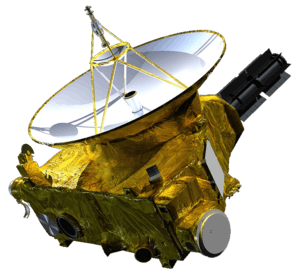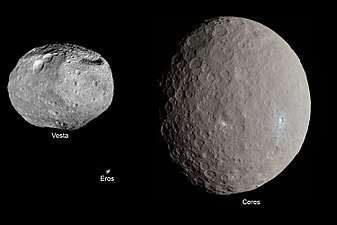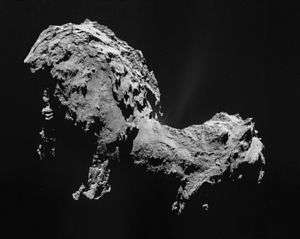Double Asteroid Redirection Test
Double Asteroid Redirection Test (DART) is a planned space probe that will demonstrate the kinetic effects of crashing an impactor spacecraft into an asteroid moon for planetary defense purposes. The mission is intended to test whether a spacecraft impact could successfully deflect an asteroid on a collision course with Earth.
 DART mission in space. | |
| Mission type | Asteroid impactor |
|---|---|
| Operator | NASA / APL |
| Website | nasa.gov/planetarydefense/dart dart |
| Spacecraft properties | |
| Manufacturer | Applied Physics Laboratory |
| Launch mass | 500 kilograms (1,100 lb) |
| Dimensions | 12.5 by 2.4 metres (41.0 ft × 7.9 ft) |
| Power | 3.5 kW [1] |
| Start of mission | |
| Launch date | 22 July 2021 [2] |
| Rocket | Falcon 9 [3] |
| Launch site | Vandenberg, SLC-4E |
| Contractor | SpaceX [3] |
| (65803) Didymos[4] impactor | |
| Spacecraft component | DART |
| Impact date | October 2022 |
A demonstration of an asteroid deflection is a key test that NASA and other agencies wish to perform before the actual need of planetary defense is present. DART is a joint project between NASA and the Johns Hopkins Applied Physics Laboratory (APL), and it is being developed under the auspices of NASA's Planetary Defense Coordination Office.
In August 2018, NASA approved the project to start the final design and assembly phase.
History
Originally, the European Space Agency (ESA) and NASA had independent plans for a mission to test asteroid deflection strategies, and by 2015 they struck a collaboration called AIDA involving two separate spacecraft launches that work in synergy.[5][6][7] Under the proposal, the European spacecraft, AIM, would have launched in December 2020, and DART in July 2021. AIM would have orbited the larger asteroid to study its composition and that of its moon. DART would then impact the asteroid's moon on October 2022, during a close approach to Earth.[6] AIM would have studied the asteroid's strength, surface physical properties, and its internal structure, as well as measure the effect on the asteroid moon's orbit around the larger asteroid. Since the AIM orbiter was cancelled, the full characterization of the asteroids will not be obtained, and the effects of the impact by DART will be monitored from ground-based telescopes and radar.[8][7]
The spacecraft's solar arrays use a Roll Out Solar Array (ROSA) design, and this was tested on the International Space Station in June 2017 as part of Expedition 52, delivered to the station by the CRS-11 commercial cargo mission.[9] In June 2017, NASA approved a move from concept development to the preliminary design phase,[10] and in August 2018 NASA approved the project to start the final design and assembly phase.[11]
On 11 April 2019, NASA announced that a SpaceX Falcon 9 would be used to launch DART.[12]
Mission

Scientists estimate 25,000 large asteroids lurk in the Solar System, though to date, surveys have detected about 8000, therefore NASA officials think it is imperative to develop an effective plan should a near-Earth object threaten Earth.[13] DART is an impactor that hosts no scientific payload other than a Sun sensor, a star tracker, and 20 cm aperture camera (DRACO) to support autonomous navigation to impact the small asteroid's moon at its center. It is estimated that the impact of the 500 kilograms (1,100 lb)[14] DART at 6 kilometres per second (3.7 mi/s)[4] will produce a velocity change on the order of 0.4 mm/s, which leads to a small change in trajectory of the asteroid system, but over time, it leads to a large shift of path.[15][6][16] Overall, DART is expected to alter the speed of Dimorphos (Didymos B) orbit by about half a millimeter per second, resulting in an orbital period change of perhaps 10 minutes.[17] Over a span of millions of kilometers, the cumulative trajectory change would turn a collision with a genuinely Earth-bound asteroid or comet into a safe outcome.[18] The actual velocity change and orbital shift will be measured a few years later by a small spacecraft called Hera that would do a detailed reconnaissance and assessment.[19] Europe's space ministers will take a final decision in November 2019 on flying the Hera mission.[20]
DART spacecraft will use the NEXT ion thruster, a type of solar electric propulsion.[8][21] It will be powered by 22 m2 solar arrays to generate the ~3.5 kW needed to power the NASA Evolutionary Xenon Thruster–Commercial (NEXT-C) engine.[1] The DART impactor is also proposed to make a flyby observation of other near-Earth asteroids such as 2001 CB21 and 3361 Orpheus during its trajectory to 65803 Didymos.[22][23][24] It will obtain some images in the visible spectrum.
It was originally planned for DART to be a secondary payload on a commercial launch to keep costs low, however a mission update presentation in November 2018 notes that the mission now has a dedicated launch vehicle.[25] In April 2019, that launch vehicle was announced to be a SpaceX Falcon 9.[12]
Secondary spacecraft
The Italian Space Agency (ASI) will contribute a secondary spacecraft called LICIACube (Light Italian CubeSat for Imaging of Asteroids), a small 6-unit CubeSat that will piggyback with DART and will separate shortly before impact to acquire images of the impact and ejecta as it drifts past the asteroid.[19][26][27][28] LICIACube will communicate directly with Earth, sending back images of the ejecta after the Dimorphos (Didymos B) flyby.[29]
In a collaborating project, the European Space Agency is formulating Hera, a spacecraft that would be launched to Didymos in 2024 [30] — after DART's impact — to do a detailed reconnaissance and assessment.[30] Hera would carry two CubeSats, APEX and Juventas.[30]
| Host spacecraft | Secondary spacecraft | Remarks |
|---|---|---|
| DART | LICIACube[31] |
|
| Hera | Juventas[32] | |
| APEX[34] | ||
| SCI |
Target asteroid
The mission's target is 65803 Didymos, a binary asteroid system in which one asteroid is orbited by a smaller one. The primary asteroid (Didymos A) is about 780 metres (2,560 ft) in diameter; its small satellite Dimorphos (Didymos B) is about 160 metres (520 ft) in diameter in an orbit about 1 km from the primary.[8] DART will target the smaller asteroid, Dimorphos. Didymos is not an Earth-crossing asteroid, and there is no possibility that the deflection experiment could create an impact hazard.[16]
See also
- Asteroid impact avoidance
- B612 Foundation
- Don Quijote (spacecraft)
- NEOCam
- Planetary defense against asteroids and comets
- The Spaceguard Foundation
References
- Adams, Elena; Oshaughnessy, Daniel; Reinhart, Matthew; John, Jeremy; Congdon, Elizabeth; Gallagher, Daniel; Abel, Elisabeth; Atchison, Justin; Fletcher, Zachary; Chen, Michelle; Heistand, Christopher; Huang, Philip; Smith, Evan; Sibol, Deane; Bekker, Dmitriy; Carrelli, David (2019). "Double Asteroid Redirection Test: The Earth Strikes Back". 2019 IEEE Aerospace Conference. pp. 1–11. doi:10.1109/AERO.2019.8742007. ISBN 978-1-5386-6854-2.
- https://nssdc.gsfc.nasa.gov/nmc/spacecraft/display.action?id=DART

- C19-009 (12 April 2019). "NASA Awards Launch Services Contract for Asteroid Redirect Test Mission". NASA. NASA. Retrieved 12 April 2019.

- Andone, Dakin (25 July 2017). "NASA unveils plan to test asteroid defense technique". CNN. Retrieved 25 July 2017.
- AIDA DART. Home page at APL.
- Asteroid Impact & Deflection Assessment (AIDA) study Archived 2015-06-07 at the Wayback Machine.
- DART, at Applied Physics Laboratory. Johns Hopkins University.
- Planetary Defense: Double Asteroid Redirection Test (DART) Mission. NASA. 2017.

- Talbert, Tricia (30 June 2017). "Double Asteroid Redirection Test (DART) Mission". NASA. Retrieved 21 January 2018.

- NASA plans to test asteroid deflection technique designed to prevent Earth impact G Brown. 4 July 2017
- Asteroid-deflection mission passes key development milestone. 7 September 2018.
- Northon, Karen (11 April 2019). "NASA Awards Launch Services Contract for Asteroid Redirect Test". NASA. Retrieved 12 April 2019.

- NASA is planning an asteroid deflection test mission in case the unthinkable happens. Science Alert. 5 July 2017.
- DART: Home page at APL Archived 2018-05-10 at the Wayback Machine. DART Spacecraft. APL, 2017.
- Cheng, A.F.; Michel, P.; Reed, C.; Galvez, A.; Carnelli, I. (2012). DART: Double Asteroid Redirection Test (PDF). European Planetary Science Congress 2012. EPSC Abstracts.
- Michel, P.; Cheng, A.; Carnelli, I.; a. Rivkin, C.; Galvez, A.; Ulamec, S.; Reed, C. (February 2015). "AIDA: Asteroid Impact and Deflection Assessment Mission Under Study at ESA and NASA" (PDF). Observatoire de la Côte d'Azur. 1829: 6008. Bibcode:2015LPICo1829.6008M. Retrieved 29 March 2015.
- Course corrector. Adam Hadhazy, Aerospace America. October 2017.
- NASA Pushes Through With Asteroid Deflection Mission That Could One Day Save Earth. The Inquisitr. 5 July 2017.
- Asteroids have been hitting the Earth for billions of years. In 2022, we hit back.Archived 2018-10-31 at the Wayback Machine Andy Rivkin, The Johns Hopkins University Applied Physics Laboratory. September 27, 2018.
- Hera: When CubeSats meet asteroid. ESA. 28 June 2019.
- Kantsiper, Brian (2017). "The Double Asteroid Redirection Test (DART) mission electric propulsion trade". 2017 IEEE Aerospace Conference. pp. 1–7. doi:10.1109/AERO.2017.7943736. ISBN 978-1-5090-1613-6.
- Cheng, Andrew F.; et al. (2018). "AIDA DART asteroid deflection test: Planetary defense and science objectives" (PDF). Planetary and Space Science. 157: 104–115. Bibcode:2018P&SS..157..104C. doi:10.1016/j.pss.2018.02.015.
- Adams, Elena. "DART – Double Asteroid Redirection Test Status NASA's mission" (PDF). Lunar and Planetary Institute. Retrieved 27 November 2019.
- Cheng, A.F.; Michel, P.; Jutzi, M.; Rivkin, A.S.; Stickle, A.; Barnouin, O.; Ernst, C.; Atchison, J.; Pravec, P.; Richardson, D.C. (2016). "Asteroid Impact & Deflection Assessment mission: Kinetic impactor". Planetary and Space Science. 121: 27–35. Bibcode:2016P&SS..121...27C. doi:10.1016/j.pss.2015.12.004.
- Cheng, Andy (15 November 2018). "DART Mission Update" (PDF). cosmos.esa.int.
- Kretschmar, Peter; Küppers, Michael (20 December 2018). "The CubeSat Revolution" (PDF). ESA. Retrieved 24 January 2019.
- Adams, Elena; Oshaughnessy, Daniel; Reinhart, Matthew; John, Jeremy; Congdon, Elizabeth; Gallagher, Daniel; Abel, Elisabeth; Atchison, Justin; Fletcher, Zachary; Chen, Michelle; Heistand, Christopher; Huang, Philip; Smith, Evan; Sibol, Deane; Bekker, Dmitriy; Carrelli, David (2019). "Double Asteroid Redirection Test: The Earth Strikes Back". 2019 IEEE Aerospace Conference. pp. 1–11. doi:10.1109/AERO.2019.8742007. ISBN 978-1-5386-6854-2.
In addition, DART is carrying a 6U CubeSat provided by Agenzia Spaziale Italiana (ASI). The CubeSat will provide imagery documentation of the impact, as well as in situ observation of the impact site and resultant ejecta plume
- Fahnestock, E.; Yu, Y.; Cheng, A. F. (2018). "DART Impact Ejecta Simulation and Visualization for Fly-Along CubeSat Operational Planning". AGU Fall Meeting Abstracts. 2018: P51A–07. Bibcode:2018AGUFM.P51A..07F.
- Cheng, Andy (15 November 2018). "DART Mission Update" (PDF). ESA. Retrieved 14 January 2019.
- Bergin, Chris (7 January 2019). "Hera adds objectives to planetary defense test mission". NASASpaceFlight.com. Retrieved 11 January 2019.
- Asteroids have been hitting the Earth for billions of years. In 2022, we hit back. Archived 2018-10-31 at the Wayback Machine Andy Rivkin, The Johns Hopkins University Applied Physics Laboratory. September 27, 2018.
- A Low-Frequency Radar to Fathom Asteroids from Juventas Cubesat on HERA. Alain Herique, Dirk Plettemeier, Wlodek Kofman, Yves Rogez, Christopher Buck, and Hannah Goldberg. EPSC Abstracts. Vol. 13, EPSC-DPS2019-807-2, 2019. EPSC-DPS Joint Meeting 2019.
- Exploration of the binary asteroid 65803 Didymos by the Hera mission. EPSC Abstracts. Vol. 13, EPSC-DPS2019-583-1, 2019. EPSC-DPS Joint Meeting 2019, 15-20 September 2019.
- "CubeSats joining Hera mission to asteroid system". Space Daily. 8 January 2019. Retrieved 11 January 2019.
- Michel, Patrick; Kueppers, Michael; Sierks, Holger; Carnelli, Ian (26 April 2017). "European component of the AIDA mission to a binary asteroid: Characterization and interpretation of the impact of the DART mission" (PDF). Advances in Space Research (Article) (published 18 December 2017). 62 (8): 2261–2272. doi:10.1016/j.asr.2017.12.020.







